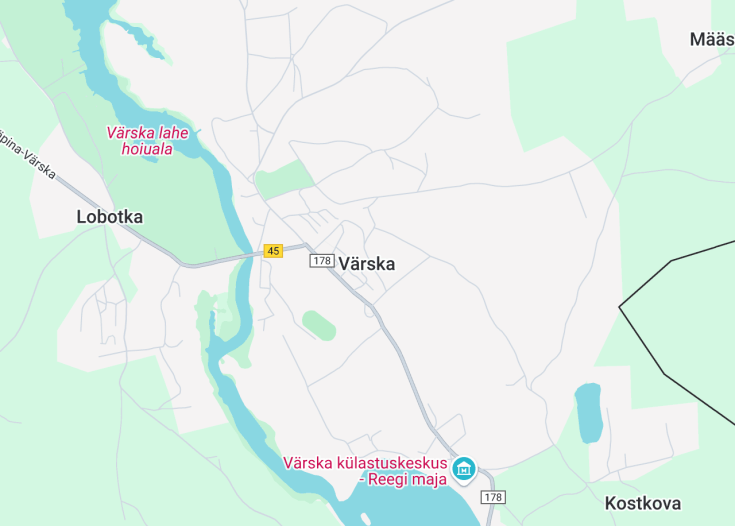Värska, a quaint town located in southeastern Estonia, is renowned for its serene landscapes and rich cultural heritage. Nestled near the shores of Lake Värska and abundant in natural mineral springs, this hidden gem offers visitors a unique blend of relaxation and exploration. The town serves as an ideal base for uncovering the picturesque surroundings, featuring charming wooden architecture and traditional Estonian cuisine. Värska is particularly celebrated for its spa facilities, which harness the therapeutic properties of local mineral water, attracting wellness seekers year-round. Additionally, the proximity to the Estonian-Russian border adds an intriguing dimension to its cultural tapestry.
When visiting Värska, consider exploring the local nature trails, which offer stunning views and opportunities for bird watching. Don’t miss the chance to sample authentic Estonian dishes at local eateries that highlight the abundance of fresh, regional ingredients.
For a truly enriching experience, plan your visit during one of Värska’s seasonal festivals. These events showcase local traditions, handicrafts, and culinary delights, providing an immersive cultural experience that celebrates the unique identity of this charming Estonian town.
Top things to do & see in Värska
Select the following sights and activities to discover best tickets and tours available in Värska.
Värska: A Hidden Gem in Estonia
| Country | Estonia |
| Time in Värska | GMT+2 |
| Language spoken | Estonian |
| Population | 1,693 (source: Estonian Statistics) |
| Currency | Euro (EUR) |
| Airports |
|
Värska is a picturesque village located in southeastern Estonia, well-known for its natural beauty and unique cultural heritage. Nestled beside the shores of Lake Värska, this charming destination is not just a feast for the eyes; it also offers a rich tapestry of history and traditions. The village is home to the famous Värska Health Spa, which dates back to the early 20th century, attracting visitors seeking wellness and relaxation through its mineral-rich waters. Over the years, Värska has preserved its unique character, showcasing traditional Seto culture, which is evident in its folk music, handicrafts, and annual festivals. The surrounding landscape is dotted with lush forests, tranquil lakes, and serene countryside, making Värska a haven for nature enthusiasts and anyone looking to escape the hustle and bustle of city life. With its authentic charm and welcoming community, Värska is becoming a notable spot on the map for travelers eager to explore Estonia’s hidden treasures.
Where is Värska?
Värska is situated in southeastern Estonia, near the borders of Russia, surrounded by beautiful nature and close to the shores of Lake Värska.
Distances:
| Route | Distance by car | Time by car |
|---|---|---|
| Tartu to Värska | 27 mi | 40 minutes |
| Tallinn to Värska | 130 mi | 2 hours 30 minutes |
| Pärnu to Värska | 110 mi | 2 hours 15 minutes |
What is Värska famous for?
Värska is renowned for its healing spa waters, traditional Seto culture, rich folklore, and stunning natural landscapes that offer peace and relaxation to visitors.
History
Prehistoric Era: 8000 – 1200 BCE
The history of Värska can be traced back to the prehistoric era when the area was inhabited by the Finno-Ugric tribes. Evidence from archaeological excavations indicates the presence of settlements characterized by hunting, fishing, and gathering activities. These early inhabitants, through their sustainable interaction with the rich natural environment, laid the foundations for the cultural and communal practices that would develop in subsequent centuries.
Medieval Period: 1200 – 1600
The medieval period marked significant changes in Värska’s landscape as the region became increasingly influenced by external powers. The establishment of the Livonian Order in the 13th century led to the introduction of Christianity and Western agricultural practices. Consequently, Värska emerged as a crucial locale along trade routes, enhancing its prominence within the region. The introduction of serfdom during the 15th century resulted in considerable social and economic alterations, affecting the local populace’s livelihoods and freedoms.
Estonian National Awakening: 19th Century
The 19th century brought about the Estonian National Awakening, a movement that sought to revive Estonian language and culture. During this time, the inhabitants of Värska began to embrace their cultural heritage more fervently, establishing schools and organizations aimed at promoting Estonian identity. This period also witnessed the growth of the local economy as agriculture and small-scale industry flourished, benefiting from burgeoning nationalism.
Estonian Independence: 1918 – 1940
Värska’s history took a significant turn with Estonia’s declaration of independence in 1918. The interwar period saw infrastructure improvements, including roads and public services, which contributed to the village’s development. Värska became a focal point for cultural and educational initiatives, fostering community spirit. However, this era was brief, as Estonia faced occupation by Soviet and Nazi forces during World War II, which had profound effects on the local population and community structures.
Post-World War II: 1945 – 1990
Following the war, Värska experienced Sovietization, which fundamentally altered the social fabric and economics of the region. Many locals were subjected to forced relocations or suppression of their cultural activities. However, despite these challenges, the community demonstrated resilience, and the preservation of local traditions remained a crucial aspect of life. Agricultural collectivization and industrialization led to significant changes, shaping the demographic landscape as people from other regions of the Soviet Union settled in Värska.
Modern Era: 1991 – Present
With the restoration of independence in 1991, Värska embarked on a new journey of growth and revitalization. The village has embraced its cultural heritage, celebrating local customs and fostering a sense of community pride. Today, Värska is known for its spa resorts, natural beauty, and as a center for the Vodka cultural heritage. The integration into the European Union in 2004 has opened new avenues for development and tourism, positioning Värska as a unique destination that preserves its rich history while looking to the future.
Visit Värska
What to see and do in Värska, Estonia.
Värska offers a rich tapestry of attractions and activities that span its cultural heritage and natural beauty. Visitors can explore:
- The Värska Spa, known for its wellness treatments and rejuvenating mineral waters.
- The Local Museum, which showcases the history and traditions of Värska and its surrounding regions.
- The scenic Värske River, ideal for leisurely walks and nature observation.
- Nearby forests and lakes, perfect for hiking, fishing, and birdwatching.
- Traditional Estonian cuisine at local restaurants, providing a glimpse into the nation’s culinary heritage.
Annual Events in Värska, Estonia
Värska hosts several recurring events throughout the year that celebrate local culture and community spirit. Notable events include the Värska Music Festival in summer, which features local and international artists, along with the annual Vodka Festival, showcasing the area’s rich distillation heritage in late autumn. Additionally, traditional harvest festivals occur in the fall, offering visitors a chance to experience Estonian customs, including folk music, dance, and local food.
Best time to visit Värska, Estonia
The best times to visit Värska are during the late spring and summer months, from May to August, when the weather is warm and conducive to outdoor activities. These months also coincide with various festivals and cultural events, allowing visitors to immerse themselves in the local traditions. Furthermore, autumn attracts visitors with its stunning foliage and harvest celebrations, while winter is ideal for those interested in exploring the serene, snowy landscapes.
Is Värska in Estonia worth visiting?
Värska is undoubtedly a destination of interest, particularly for those seeking to explore Estonia’s rich cultural and historical landscape. The village offers a serene environment complemented by beautiful natural surroundings, making it suitable for nature enthusiasts. However, visitors may encounter challenges such as limited accommodation options and accessibility issues during the off-peak season. Overall, Värska presents a unique blend of tradition and tranquility, making it worthwhile for travelers seeking an authentic Estonian experience.
What are the main attractions in Värska?
- Värska Water Park: A popular spot for both relaxation and entertainment featuring pools, saunas, and wellness treatments.
- The Värska Cultural Centre: This center hosts various cultural events and exhibitions showcasing local artists and traditions.
- Muratsi Lighthouse: A scenic landmark offering beautiful views and a glimpse into the maritime history of the region.
- Seto Heritage Centre: A place to learn about the unique Seto culture, including exhibitions on traditional music, crafts, and cuisine.
These attractions offer a mix of relaxation, culture, and history for visitors to enjoy in Värska.
What outdoor activities can I do in Värska?
- Hiking: Explore the surrounding hills and forests with numerous hiking trails that cater to all skill levels.
- Cycling: Rent a bike and enjoy the scenic routes along lakes and through the picturesque countryside.
- Birdwatching: The nearby wetlands are a haven for bird enthusiasts, especially during migration seasons.
- Water Sports: Engage in kayaking or paddleboarding on Lake Värska, perfect for both novices and experienced enthusiasts.
These activities provide an excellent opportunity to immerse yourself in nature and enjoy the tranquil surroundings.
Where can I experience local cuisine in Värska?
- Seto Cuisine: Try traditional dishes such as “kamarasalat” (a dessert made of curds), “sült” (jellied meat), and “piim” (milk) in local restaurants.
- Restaurants: Visit establishments like Värska Restaurant or the café at the Seto Heritage Centre, where you can find both local and modern interpretations of Seto dishes.
- Food Festivals: Check if there are any local food festivals during your visit, which often feature various Seto dishes and local produce.
Don’t miss out on the chance to savor the distinct flavors of Seto cuisine during your trip to Värska!
Are there good accommodation options in Värska?
- Hotels: There are several hotels in Värska providing comfortable rooms and modern amenities. Notable options include the Värska Spa Hotel.
- Guesthouses: Enjoy a more homely stay at guesthouses that often include local hospitality and home-cooked meals.
- Campsites: For those who love the outdoors, there are campsites available near Lake Värska, allowing for a nature-oriented experience.
Whether you prefer luxury or a cozy guesthouse atmosphere, Värska has something to accommodate every traveler’s needs.
What cultural experiences are available in Värska?
- Seto Traditions: Attend local festivities or events that highlight Seto folklore, music, and rituals.
- Workshops: Participate in workshops on traditional crafts such as weaving, pottery, or cooking native Seto dishes.
- Local Music: Enjoy performances by local musicians showcasing Seto songs and dances, often held at cultural centers or during local festivals.
These cultural experiences provide a deeper understanding of the local community’s heritage and traditions.
What is the best time to visit Värska?
- Summer (June to August): Ideal for outdoor activities like hiking, swimming, and enjoying local events and festivals, with pleasant weather.
- Autumn (September to October): Autumn is beautiful with stunning foliage and a quieter atmosphere, perfect for those who prefer fewer crowds.
- Winter (November to March): Offers snow-related activities and winter sports but may be cold, so dress warmly.
- Spring (April to May): A lovely time to see blooming nature, great for birdwatching and revitalizing outdoor adventures.
Each season has its charm, making Värska worthwhile to visit at any time of the year.
Can I get around easily in Värska?
- Walking: The town is compact enough to walk around, allowing you to explore attractions at your own pace.
- Bicycles: Renting a bicycle is a popular option, with dedicated paths around the town and the surrounding countryside.
- Public Transport: Local buses connect Värska to nearby towns, making it easy to explore the broader region.
- Taxi Services: Taxis are available for those who prefer a quicker, more direct option.
Navigating Värska is quite easy, ensuring a pleasant experience for visitors.
Is there a local market in Värska?
- Fresh Produce: The market typically features fresh fruits and vegetables, often sourced from local farmers.
- Handicrafts: Local artisans sell handmade crafts, textiles, and other unique souvenirs representing the Seto culture.
- Food Stalls: Enjoy traditional Estonian culinary delights at food stalls, providing a delicious taste of the region.
Visiting the local market is a great way to immerse yourself in the local culture and pick up some artisanal souvenirs.
What language do locals speak in Värska?
- Seto Language: The Seto community has its own language, which may be heard among older locals and in cultural settings.
- English: Many young people and those working in tourism speak English, especially in shops and restaurants.
- Russian: Due to the region’s history, some residents may also speak Russian, particularly among the older population.
While learning a few basic phrases in Estonian can enhance your experience, you should find it relatively easy to communicate in English as well.
What unique experiences does Värska offer?
- Seto National Costume: Experience traditional Seto dances and music performances while dressed in their colorful national costumes during local events.
- Local Cuisine Workshops: Participate in cooking classes focusing on Seto dishes, a great way to learn about the culinary culture.
- Nature Retreats: Engage in wellness retreats combining relaxation with wellness activities amid the serene landscapes surrounding Värska.
These unique experiences provide insightful glimpses into local culture and natural beauty.














